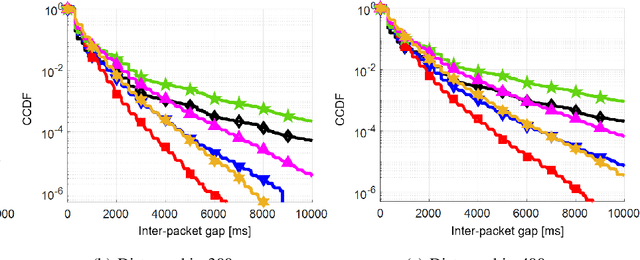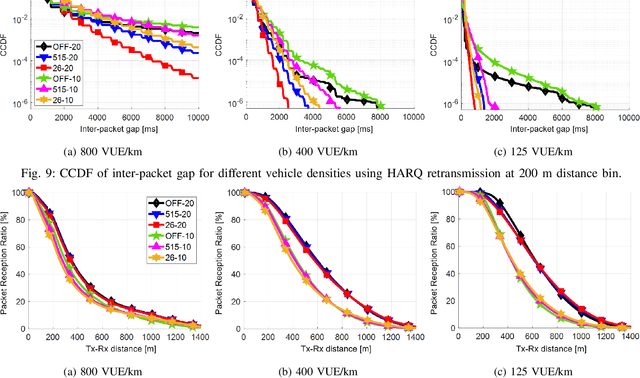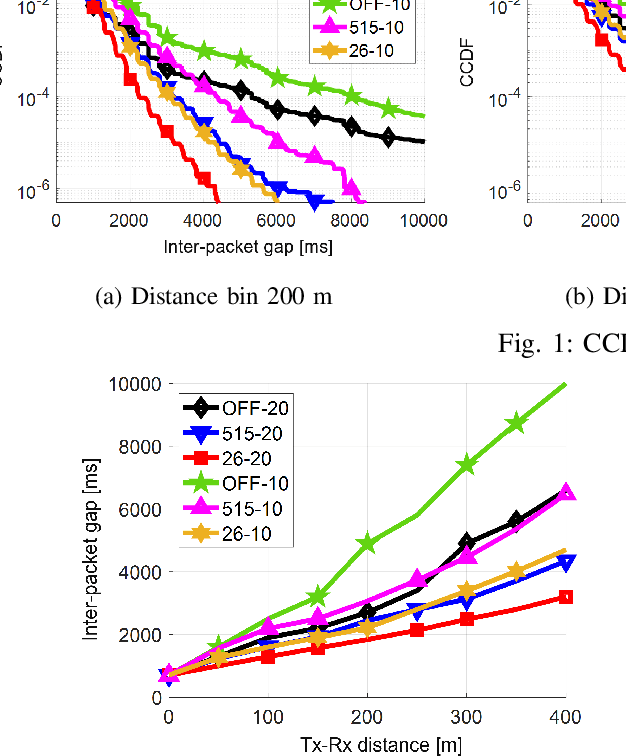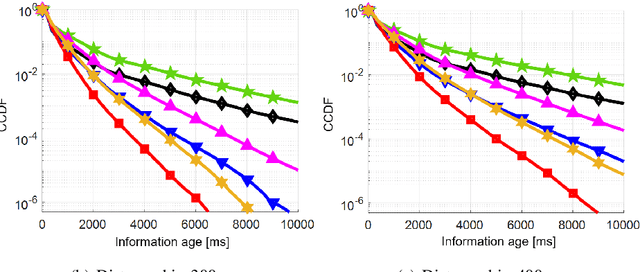Ivan Vukovic
HARQ Retransmissions in C-V2X: A BSM Latency Analysis
Nov 28, 2023



Abstract:Cellular vehicular-to-everything (C-V2X) systems offer the potential for improving road safety, in part through the exchange of periodic basic safety messages (BSMs) between nearby vehicles. The reliability and latency of these messages is a key metric. Hybrid automatic repeat request (HARQ) retransmissions are one technique used to this end. However, HARQ may come at the expense of consuming the limited available wireless resources, especially in highly congested scenarios. This paper studies BSM transmission latency and reliability when HARQ retransmissions are used with the semi-persistent scheduling (SPS) in C-V2X transmission mode 4. We do so through extensive system-level simulations that closely follow the SPS process. Furthermore, we provide an analytical model for the tail behavior of the BSM latency distribution with HARQ retransmissions that is a good approximation to the simulation results. Our study reveals the impact of several deployment settings (e.g., bandwidth configurations and vehicle density).
Study of BSM Inter-Packet Gap Tails in C-V2X Networks
Nov 28, 2023Abstract:Cellular vehicle-to-everything (C-V2X) enables safety-critical connected vehicular service by exchanging basic safety messages (BSMs) among nearby vehicular users (VUEs). Timely transmission of BSMs is crucial to avoid stale information at VUEs. However, successive packet losses can lead to large inter-packet gaps (IPGs), reducing the BSMs' reliability. This paper investigates the tail behavior of IPG and information age (IA) distributions in C-V2X mode 4, a decentralized resource allocation method based on semi-persistent scheduling (SPS). We study the improvements and trade-offs introduced by SAE one-shot transmission to decrease the number of successive BSM losses at destination VUEs. The study employs high-fidelity system-level simulations that closely follow the SPS process of CV2X mode 4 to evaluate the performance of interleaved one-shot SPS transmissions. The numerical results demonstrate significant improvement in the IPG and IA tail distributions in various simulation scenarios. Additionally, we propose an accurate analytical model to characterize the IPG tail behavior of C-V2X BSM transmissions. The proposed model is validated by comparing its results with those obtained using the system-level simulations. Our validation shows that the proposed model generates analytical results that coincide with the asymptotic slopes of IPG distribution in different BSM transmission modes.
Interleaved One-shot Semi-Persistent Scheduling for BSM Transmissions in C-V2X Networks
Sep 30, 2021



Abstract:Cellular vehicle-to-everything (C-V2X) networks are regarded as one of the main pillars to enable efficient and sustainable Intelligent Transportation Systems (ITS) safety applications and services. Such services rely on the concept of exchanging periodic status updates (i.e., basic safety messages (BSMs)) between nearby vehicular users (VUEs). Hence, it is essential to ensure small inter-packet gaps (IPGs) between successive BSMs from nearby VUEs. Large IPGs, due to successive packet losses, can result in stale information at a VUE. In this paper, we study the tail behavior of the IPG and the information age (IA) distributions using C-V2X transmission mode 4 (a decentralized resource allocation method based on semi-persistent scheduling (SPS)). Specifically, we investigate improvements and trade-offs introduced by the SAE-specified concept of one-shot transmissions. We use a high-fidelity system-level simulator that closely follows the SPS process of C-V2X transmission mode 4 to evaluate the performance of the interleaved one-shot SPS transmissions. Our numerical results show that the tails of the IA and IPG complementary cumulative distribution functions (CCDFs) are significantly improved when one-shot transmissions are enabled in various simulation scenarios.
 Add to Chrome
Add to Chrome Add to Firefox
Add to Firefox Add to Edge
Add to Edge